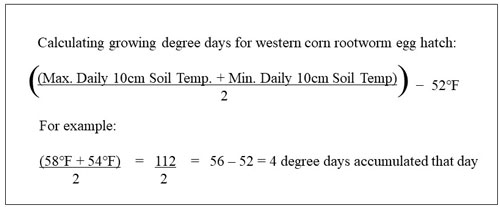Degree-day models are useful tools for estimating the development of many different insects, allowing us to predict when potential pests might begin to impact a crop. In the case of the Western Corn Rootworm (WCR), degree-day calculations can be used to determine the onset of egg hatch in an area, peak egg hatch and the timing of adult emergence.
The most damaging stage of WCR is the larval stage. Freshly hatched larvae feed on root hairs and the surface of young roots. As they grow, feeding intensifies and the larvae start tunneling into larger roots and begin pruning developing tips of brace roots. Yield loss occurs when severe infestations weaken the root system, causing plants to lodge. Without adequate scouting, often times the problem is not apparent until it is too late. Having an estimate on when eggs are going to start hatching and peak in an area will ensure that scouting is done when root damage is fresh, easy to identify and, most importantly, before the damage becomes severe.
Growing degree days for WCR egg hatch
As with all degree-day models, the base temperature, or developmental threshold, will be important for predicting rootworm hatch and emergence. Western corn rootworm eggs are laid in summer and overwinter in the soil. The following spring, a threshold soil temperature of 52°F or higher will trigger eggs to begin developing. This base temperature along with daily 10cm high and low soil temperatures are used to monitor egg hatch using the formula below (Figure 1). It is important to note that degree day calculations for egg hatch should begin starting January 1 of the current year.

Figure 1. Formula and example calculation for determining growing degree days for Western Corn Rootworm egg hatch.
Eggs should begin hatching after approximately 380 degree days have accumulated. Peak egg hatch occurs between 684-767 accumulated degree days. Examining corn roots for damage 10 to 14 days following peak hatch is recommended since feeding damage will be fresh and easier to detect.
Growing degree days for WCR adult emergence
As with egg hatch, knowing when adult rootworms might be emerging in the field will help make sure both scouting efforts and insecticide applications are timed correctly. Male and female corn rootworms emerge at different times. Peak male emergence is always prior to peak female emergence. This life strategy ensures that males will always have access to newly emerged females. If insecticide applications are to be made in order to reduce egg laying, spraying too soon when the field is predominantly occupied by male beetles will do nothing to reduce potential rootworm pressure the following season.
Using this method to estimate adult emergence is not meant to replace scouting, in fact this requires scouting to begin earlier than beetles should be emerging. The reason for this is to determine a “biofix”. Rather than simply using January 1 of the current year, the biofix is the point in time when degree days begin to accumulate and, in this case, the biofix is the date that an adult rootworm is first observed or trapped in a field. Another important difference with the adult emergence model is that air temperature data is used instead of soil temperature.

Figure 2. Formula and example calculation for determining growing degree days for Western Corn Rootworm adult emergence.
While male rootworm emergence begins before female emergence, there is overlap. Peak male emergence can be expected at approximately 118 degree days and with 505 accumulated degree days male emergence should be concluded. Peak female emergence can be expected at approximately 245 degree days and concludes at 629 degree days. Scouting will require more effort and time; if the first beetle detected is a female, the window of opportunity to use this tool has already passed.
Anthony Zukoff, Extension Entomologist – Garden City
azukoff@ksu.edu
Tags: corn rootworm growing degree days western corn rootworm